We usually associate technological progress with a better life for everyone. Most of us agree that life is better now than 2000 years ago. Yet, many of you reading this blog are likely in a privileged position and personal opinions are generally not a good way to assess the quality of life of an entire species.
Let’s look at an example. The invention of mobile phones has allowed for a more interconnected world. With economies of scale and improved production processes the prices of these devices have dropped enormously over the years. This has allowed less wealthy individuals, such as many African farmers, to purchase them. This lead to them being able to check market prices, accept payments in mobile money and communicate with middlemen more effectively (The Economist, 2016).
It sounds then like this is technological progress does indeed increase the prosperity of humanity. Jaumotte et al. (2013) came slightly more nuanced conclusion when they conducted their research for the International Monetary Fund. Although it is widely accepted that economic growth is related to technological development, their research focused on how this wealth is distributed. Their research concluded that “the observed rise in inequality across both developed and developing countries over the past two decades could be largely attributable to the impact of technological change.” They do note that these results are not definitive as their conclusions were based on a short unbalanced panel data set and with estimations that suffer from endogeneity issues.
This does lead to the question: does technological progress encourage income inequality? Usually it is the upper-class that profits from the latest technological innovations, with the lower class struggling to keep up. As mentioned before, the lower classes do receive benefits, but these are usually delayed to when a technology has been refined to the point where it becomes affordable. This leads us to reason that technological change has, so far, increased the quality of life of most people, but it increases that of the upper-class the most.
Bibliography
Economist.com. (2017). Cite a Website – Cite This For Me. [online] Available at: https://www.economist.com/news/middle-east-and-africa/21711511-mobile-phones-are-transforming-africa-where-they-can-get-signal-mobile-phones [Accessed 16 Oct. 2017].
Jaumotte, F., Lall, S. and Papageorgiou, C. (2013). Rising Income Inequality: Technology, or Trade and Financial Globalization?. IMF Economic Review, 61(2), pp.271-309.



